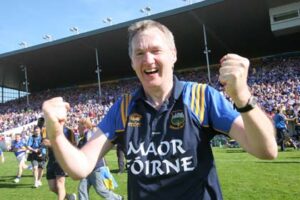THERE’S NO DOUBT that hurlers can get most animated at any talk of adjusting their equipment. There’s been debate of late concerning the soon to be mandatory use of hurling helmets at all ages and levels, and sure a while back the issue of players wishing to use their own balls was much reported.
Now, research carried out by one of Ireland’s leading universities has uncovered clear evidence that the majority of hurleys manufactured in Ireland over the last twenty years have in fact been what are known as ‘left-handed hurleys’.
It is believed the error dates back to a secret directive issued by the Powers that Be in the early eighties that pointed out increased concerns over health and safety due to overhead pulling and the gradual decrease in ground hurling. Amongst other recommendations, the seventies think-tank believed that the introduction of helmets would in part alleviate the problem. But, in addition, they wished to regulate the size of the bas on the hurl.
After much research, a sample of the ideal hurley was sent to every hurley maker in Ireland with clear instructions on future stick production. In those days, unlike today when you can’t go round a corner without someone carving away on their caman, there were much fewer men (and women) crafting the ash and therefore regulation was much easier.
Unfortunately, the hurls chosen as the original of the species and therefore the protoype for future iomanadors, and from which the vast majority of hurls in Ireland have since descended, were a batch made specially for the famous ciotóg hurler Jimmy Doyle of Thurles Sarsfields and Tipp.
He specified to his hurley maker, Pat Óg Leahy that the heel of the hurl should have a slightly elevated angle on one side, all the better to cut the ball (in the manner of Joe Canning et al nowadays) and also a small indent was planed into the bas to enable easier carrying of the ball whilst soloing.
In addition the protruding bit on the handle was carved longer than normal as yer man occasionally was bothered by an itch and he found a good scratch with the butt of his stick eased the discomfort. Even nowadays an observant viewer can watch the way hurlers and Camogs alike rest on the convenient handle of the stick during breaks in coaching, teamtalks, the national anthem and the like.
Sources have revealed they will be issuing new guidelines on hurleys to ensure that in future more right-handed sticks are produced the length and breadth of the country.
It is believed this innovation will help the promotion of hurling countrywide and may indeed increase further the volume of scores from sideline balls and generally help the weaker counties develop.
Readers are therefore encouraged to check at home, in the garage, under the stairs, in the shed, and in the fertilizer bag and remove all left-handed hurls for destruction immediately.
We would caution that you burn hurleys one at a time due to the combustible nature of ash. You don’t want to be scorching the thatch now do you?

